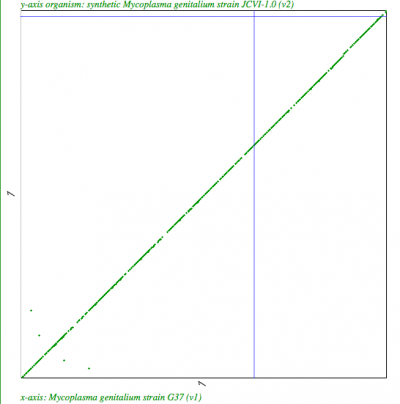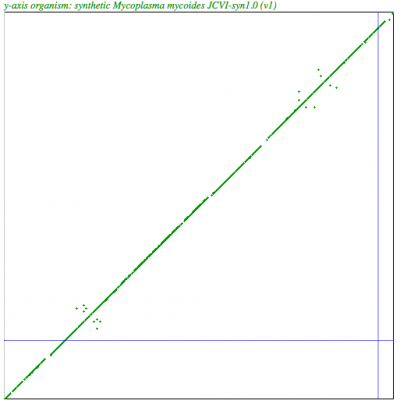Jcvi code
Background
Rumor has it that there is a code in one of the synthetic genomes by JCVI. Supposedly, this code contains an email address or a URL (or a secret message from Dr. V!). I wanted to know if CoGe's comparative genomics tools would make this relatively easy to do.
Synthetic JCVI genomes in CoGe
- synthetic Mycoplasma genitalium strain JCVI-1.0: http://genomevolution.org/CoGe/OrganismView.pl?oid=35986
- synthetic Mycoplasma mycoides JCVI-syn1.0: http://genomevolution.org/CoGe/OrganismView.pl?oid=35385
Methods
- Find closest natural relatives
- Identify syntenic discontinuities (this is where the new JCVI code should reside
- Decode new sequence
- Identify coding scheme
- Probably using natural codon triplet encoding given that:
- 1x4 encoding = 4 letters
- 2x4 encoding = 16 letters
- 3x4 encoding = 64 letters
- Given that there are 20ish natural amino acids, some of the codons will be appropriated for additional letters and symbols
- An example for students of expanded codon encoding (using neighboring codons for additional letters): http://nature.ca/genome/05/051/0511/0511_m205_e.cfm
- Probably using natural codon triplet encoding given that:
- Decode email address
- Identify coding scheme
- Valid email address
Closest natural relatives
| Syntenic dotplot of synthetic Mycoplasma genitalium strain JCVI-1.0 (y-axis) v. Mycoplasma genitalium strain G37 (x-axis) http://genomevolution.org/r/4mx1 | Syntenic dotplot of synthetic Mycoplasma mycoides JCVI-syn1.0 (y-axis) v. Mycoplasma mycoides subsp. capri strain GM12 (x-axis) http://genomevolution.org/r/4mx2 |

|

|
GEvo Analyses: high-resolution detection of syntenic discontinuities
Genitalium
Mycoides

| Region | Notes |
 |
Annotation talks about how a piece of e. coli made it into this area. Not the greener region (GC rich). When that sequence is extracted and blasted against E. coli, get a very high quality hit (95%). http://genomevolution.org/CoGe//CoGeBlast.pl?chr=contig_sMmYCp235-1&upstream=308819&downstream=309545&dsid=59166&rc=0&gstid=1 |
 |
http://genomevolution.org/CoGe//SeqView.pl?dsid=59166&chr=contig_sMmYCp235-1&start=389504&stop=390368&gstid=1. There is an obvious "new thing" that is annotated as a hypothetical protein predicted by glimmer. Gene it replaces is a transposon (which wouldn't be missed). This sequence does not match anything in K12 MG1655. Its sequence, when 6-frame translated, yields one frame that contains several "CVI" amino acid sequences. This sequence hasn't been seen in other aa sequences from this genome. Obvious email/web address did not jump out. |
 |
http://genomevolution.org/CoGe//SeqView.pl?dsid=59166&chr=contig_sMmYCp235-1&start=565568&stop=566608&gstid=1 . Did not match anything in E. coli. No obvious words. Disrupted (removed) WT ABC transporters. |
 |
http://genomevolution.org/CoGe//SeqView.pl?dsid=59166&chr=contig_sMmYCp235-1&start=725610&stop=726650&gstid=1 . Did not match anything in E. coli. Did contain VCI. Interrupted WT "Type III restriction-modification system is named MmyCI" |
 |
http://genomevolution.org/CoGe//SeqView.pl?dsid=59166&chr=contig_sMmYCp235-1&start=958651&stop=959707&gstid=1 . Did not match anything in E. coli. Did contain VCI. Interrupting a WT transposon. Hit nothing else in NCBI NR database. |
Hints From the Paper and Craig V.
The paper describes four watermark sequences added to the genome. CoGe correctly identified these (along with the carryover piece of E. coli). There is a video and associated articles from Craig describing that the four watermarks contain special phrases. One of which is the URL/email address.
- Paper: http://www.sciencemag.org/content/329/5987/52.abstract
- Sup Data: http://www.sciencemag.org/content/suppl/2010/05/18/science.1190719.DC1/Gibson.SOM.pdf
- http://www.popsci.com/science/article/2010-05/venter-institutes-synthetic-cell-genome-contains-hidden-messages-watermarks
- http://en.wikipedia.org/wiki/Mycoplasma_laboratorium
- JCVI code phrases
- JCVI watermarks (without end sequences)
- Aligned 6-frame translation of watermark 4 shows nothing that matches phrase 4
Decoding part one
The code is something different than using protein translation. Also, there needs to be a way to code special characters, such as "," or ":", etc.
JCVI GEvo analysis of watermarks JCVI notes
Cracking the code (from the repeat sequences)
ATA AAC CTG GGC TAA <s> l i f e TGA ATA TAG GCT ATA TGA TCA TAA CAT ATA t <s> a s <s> t h e y <s> ATA CTG ATA TTT TAG TGC TGC CGT TGA ATA <s> I <s> c a n n o t <s> :)
- Notes:
- spaces all use the same triplet (ATA)
- lower case "i" and upper-case "I" both use the same triplet (CTG): code is case insensitive
First pass output
Not too bad.
There is an obvious "decoding" section in the line without a quote (along with some HTML tags)
Second pass
Solving the code from this point is pretty straight forward. Mostly a matter of looking for obvious characters, plugging them in, rerunning the program, and repeat. There is a decoding section in the first watermark, but I did not decode all of the symbols. I'm guessing there are a variety of other ASCII characters such as "(){}[]|?/\" and whatnot. "?" in the text are those symbols that I did not decode.
Watermark one
J. CRAIG VENTER INSTITUTE 2009 ABCDEFGHIJKLMNOPQRSTUVWXYZ 0123456789?@??-??=/:<?>??????"??!'., SYNTHETIC GENOMICS, INC. <!DOCTYPE HTML><HTML><HEAD><TITLE>GENOME TEAM</TITLE></HEAD><BODY><A HREF="HTTP://WWW.JCVI.ORG/">THE JCVI</A><P>PROVE YOU'VE DECODED THIS WATERMARK BY EMAILING US <A HREF="MAILTO:XXXXXXXX@JCVI.ORG">HERE!</A></P></BODY></HTML>
Watermark two
MIKKEL ALGIRE, MICHAEL MONTAGUE, SANJAY VASHEE, CAROLE LARTIGUE, CHUCK MERRYMAN, NINA ALPEROVICH, NACYRA ASSAD-GARCIA, GWYN BENDERS, RAY-YUAN CHUANG, EVGENIA DENISOVA, DANIEL GIBSON, JOHN GLASS, ZHI-QING QI. "TO LIVE, TO ERR, TO FALL, TO TRIUMPH, TO RECREATE LIFE OUT OF LIFE." - JAMES JOYCE
Watermark three
CLYDE HUTCHISON, ADRIANA JIGA, RADHA KRISHNAKUMAR, JAN MOY, MONZIA MOODIE, MARVIN FRAZIER, HOLLY BADEN-TILSON, JASON MITCHELL, DANA BUSAM, JUSTIN JOHNSON, LAKSHMI DEVI VISWANATHAN, JESSICA HOSTETLER, ROBERT FRIEDMAN, VLADIMIR NOSKOV, JAYSHREE ZAVERI. "SEE THINGS NOT AS THEY ARE, BUT AS THEY MIGHT BE."
Watermark four
CYNTHIA ANDREWS-PFANNKOCH, QUANG PHAN, LI MA, HAMILTON SMITH, ADI RAMON, CHRISTIAN TAGWERKER, J CRAIG VENTER, EULA WILTURNER, LEI YOUNG, SHIBU YOOSEPH, PRABHA IYER, TIM STOCKWELL, DIANA RADUNE, BRIDGET SZCZYPINSKI, SCOTT DURKIN, NADIA FEDOROVA, JAVIER QUINONES, HANNA TEKLEAB. "WHAT I CANNOT BUILD, I CANNOT UNDERSTAND." - RICHARD FEYNMAN
Conclusion
CoGe definitely helped. Using CoGe did permit the rapid identification of the watermark sequences and checking whether they were unique sequences (e.g. came from E. coli), those watermark sequences were given in the supplementary data. Having some of the code broken made the cracking of it pretty simple when using GEvo to compare within and among the watermark sequences. This quickly showed that watermark one was very different in structure than the other three. In addition, each of the other three watermark sequences has a relatively large identical repeat sequence, which permitted decoding the first set of works, locating their placement within the quotations and the watermarks, and using them to build a cipher to decode the rest of the sequences. All in all, a lot more fun than Sudoku!